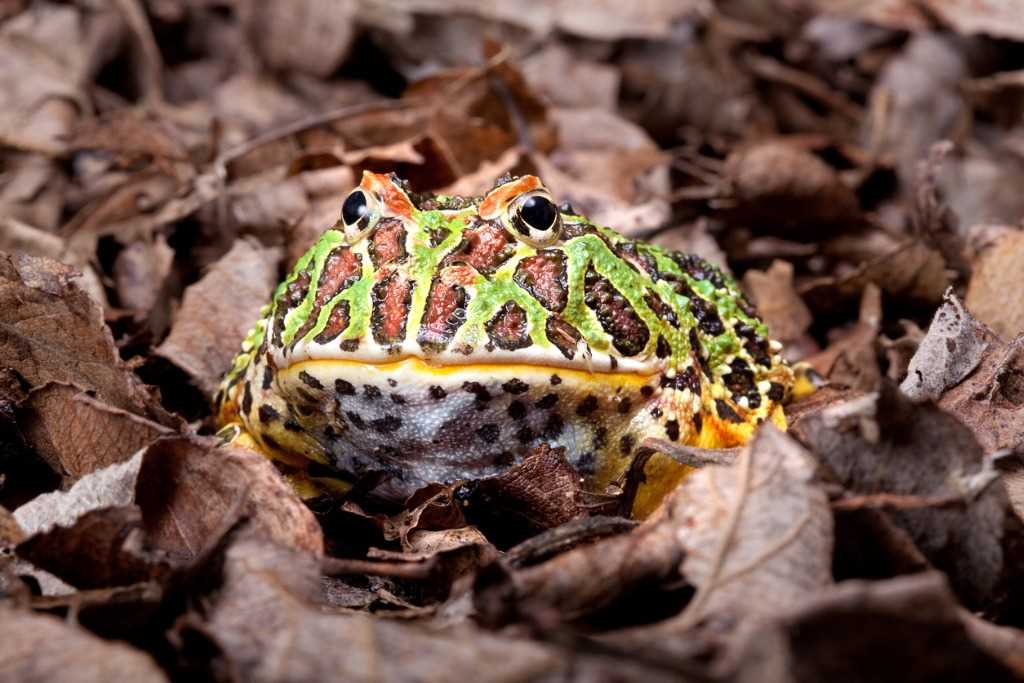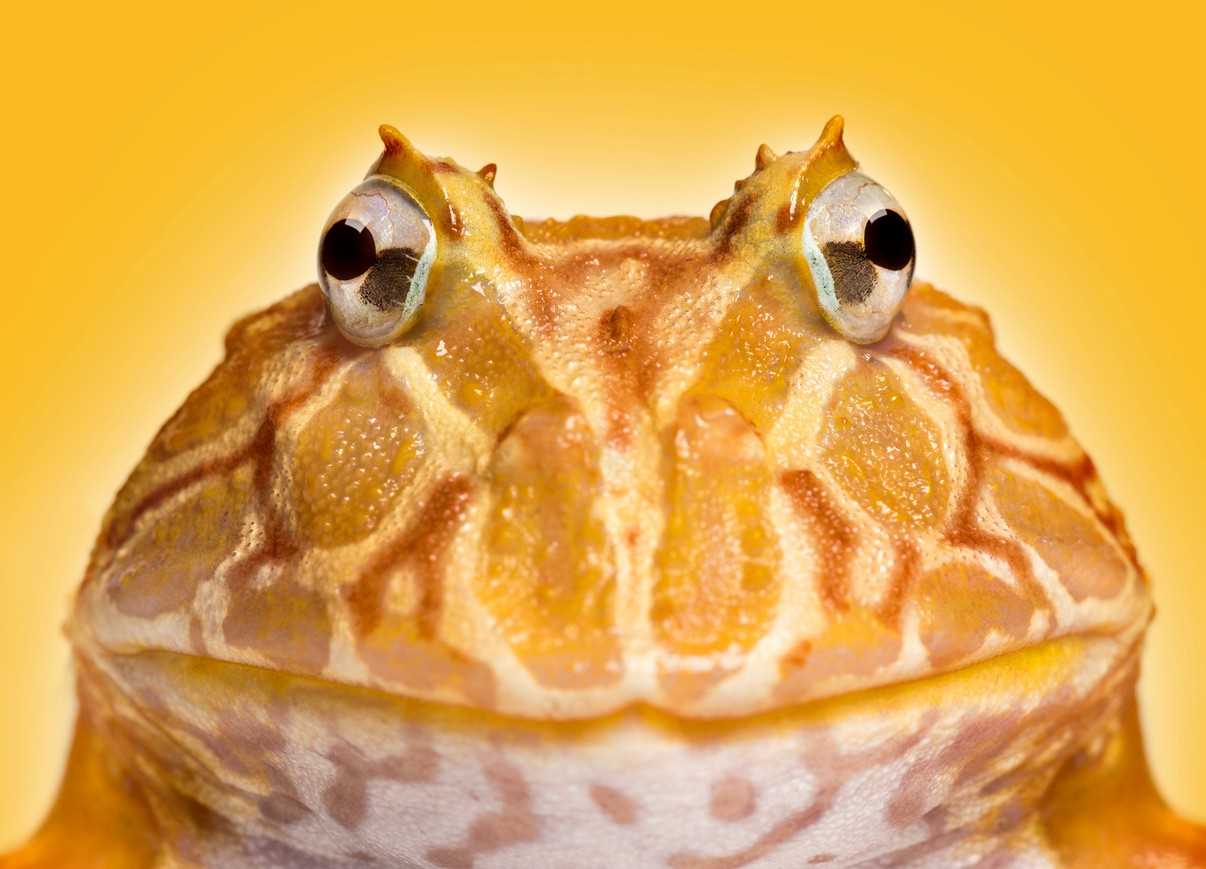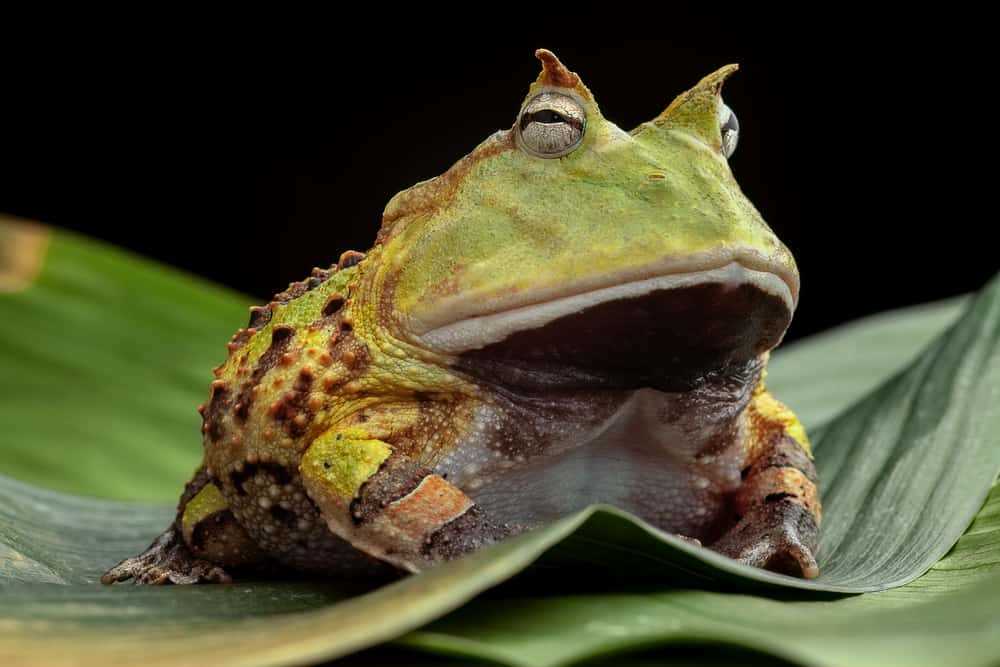
While Pacman frogs are not poisonous, they do have a unique defense mechanism. When threatened, these frogs will puff themselves up and let out a loud hissing noise. They may also bite and scratch their attackers. These behaviors are meant to scare away predators and ensure the frog’s survival.
What is a Pacman Frog?
Despite their name, Pacman Frogs are not actually frogs that eat other frogs or ghosts. They are ambush predators that mainly eat insects, small rodents, and even other frogs in the wild. They have a voracious appetite and will eat almost anything that fits into their mouths.
Pacman Frogs can grow to be quite large, reaching sizes of up to 8 inches in diameter. They have a round, fat body with short legs and a wide mouth. Their skin can come in a variety of colors, including green, albino, and even blue, depending on their genetic makeup and environmental factors.
These frogs are relatively easy to care for and make great pets for both beginner and experienced amphibian keepers. They have a long lifespan, with some individuals living up to 10-15 years in captivity with proper care. Pacman Frogs are also known for their unique behaviors, such as burying themselves in substrate and waiting patiently for prey to pass by before striking.
Physical Features of a Pacman Frog
One of the most distinctive physical features of a Pacman frog is its large mouth. They have a wide gape that allows them to swallow prey that is almost their own size. Their mouths are lined with sharp teeth-like structures called maxillary teeth that help them grip and swallow their food.
Pacman frogs have a compact and robust body, with a flattened appearance. They have short limbs and strong front legs that are used for digging and burrowing. These frogs are excellent diggers and spend a lot of their time underground, which is why they need a substrate that allows them to burrow.
The skin of a Pacman frog is thick and warty, providing them with excellent protection. They come in a variety of colors, including shades of green, brown, and even albino. Their skin also has a bumpy texture, which helps them blend in with their natural habitat.
Another interesting feature of a Pacman frog is their eyes. They have large bulging eyes positioned on the sides of their head, giving them a wide field of vision. These eyes are adapted for spotting prey and predators, making them skilled hunters.
Overall, Pacman frogs have a unique and captivating appearance. Their large mouth, robust body, warty skin, and bulging eyes make them stand out among other frogs. Whether you are considering getting a Pacman frog as a pet or simply want to learn more about these fascinating creatures, their physical features are sure to leave a lasting impression.
Where do Pacman Frogs Live?
Within their natural habitats, Pacman frogs can be found in shallow bodies of water such as marshes and ponds. They are skilled burrowers and often hide beneath leaf litter, fallen logs, or in underground burrows that they create themselves. These burrows help them escape from extreme temperatures and predators while also providing a safe and moist environment.
Pacman frogs are not particularly mobile creatures and tend to stay within their chosen burrows or immediate surroundings. They are also excellent ambush predators, relying on their unique shape and camouflage to blend into their surroundings and wait for prey to come close enough for them to strike.
While Pacman frogs have a native habitat in South America, they have become popular pets worldwide due to their unique appearance and relatively low maintenance requirements. Many Pacman frog owners create artificial terrariums or vivariums that closely mimic their natural habitats, allowing these fascinating creatures to thrive in captivity.
Are Pacman Frogs Poisonous?
While pacman frogs do secrete a toxin, it is not usually dangerous to humans. The toxin is primarily used as a defense mechanism to ward off predators. When threatened, the pacman frog will puff itself up and arch its back, revealing the bright coloration on its underside. At the same time, it may also release a milky substance from its skin. This substance contains a mild toxin that can cause irritation if it comes into contact with human skin or eyes. However, the toxin is not strong enough to be fatal or cause any serious harm.
Types of Pacman Frogs
2. Albino Pacman Frog: These frogs have a lack of melanin, which gives them a pale, almost translucent appearance. Their red eyes stand out against their light-colored skin, making them quite striking.
3. Strawberry Pacman Frog: These frogs have a reddish-pink coloration, resembling a ripe strawberry. They are quite popular due to their unique appearance.
5. Blue Pacman Frog: These frogs have a bluish hue to their skin, making them stand out among other pacman frogs. Blue pacman frogs are relatively rare and highly prized by collectors.
6. Fantasy Pacman Frog: These frogs have a mixture of different colors and patterns on their skin, creating a unique and whimsical appearance. They can have a combination of blue, red, yellow, and green hues, making each frog truly one-of-a-kind.
How to Care for a Pacman Frog
1. Housing: Provide a spacious enclosure with a secure lid to prevent escapes. A 10-gallon tank is sufficient for a single adult frog. Use a substrate like coconut fiber or moss to maintain humidity levels and create a naturalistic environment.
2. Temperature and Humidity: Maintain a temperature range of 75-85°F (24-29°C) during the day and a slight drop at night. Use a heat lamp or ceramic heater to achieve the desired temperature. Keep humidity levels between 50-80%, using a hygrometer to monitor.
3. Lighting: Pacman frogs are nocturnal, so they don’t require UVB lighting. However, providing a 12-hour light-dark cycle helps regulate their natural behavior and promotes a healthy day-night rhythm.
4. Feeding: Pacman frogs are voracious eaters, consuming a variety of prey items. Offer appropriately sized live or frozen-thawed insects, such as crickets, mealworms, and roaches. Be sure to gut-load and dust prey with calcium and vitamin supplements for optimal nutrition.
5. Water and Hydration: Provide a shallow dish of dechlorinated water for drinking and soaking. Mist the enclosure daily to maintain humidity and provide hydration for the frog. Ensure the water dish is shallow enough to prevent drowning.
6. Handling: Pacman frogs have a strong bite and can become stressed by handling, so it’s best to limit interaction. If necessary, use gloves or damp hands to handle them gently and avoid sudden movements.
7. Health Check: Regularly inspect your frog for any signs of illness or injury. Watch for changes in appetite, activity level, skin condition, and abnormal droppings. Seek veterinary care if you notice any concerning symptoms.
8. Cleaning: Regularly clean the enclosure by removing waste, replacing soiled substrate, and disinfecting the tank. Use reptile-safe cleaners and avoid harsh chemicals that could be harmful to the frog.
By following these care guidelines, you can ensure a healthy and thriving life for your Pacman frog. Remember to research and understand the specific needs of your frog’s species to provide the best care possible.
Feeding a Pacman Frog
One of the most important aspects of caring for a Pacman frog is providing it with the proper diet. These frogs are insectivorous, which means they primarily eat insects.
In addition to live insects, some Pacman frogs can also be offered thawed, appropriately-sized frozen rodents as an occasional treat. However, this should not make up the majority of their diet, as it can lead to nutritional imbalances.
Conclusion
Creating the Perfect Habitat for a Pacman Frog
Pacman frogs are unique amphibians that require a specific habitat to thrive. Creating the perfect habitat for a Pacman frog involves careful consideration of their natural environment and meeting their specific needs.
Temperature and Humidity
Pacman frogs are native to the warm and humid regions of South America. Therefore, it is crucial to maintain the appropriate temperature and humidity levels in their habitat. The temperature should range between 75 to 85 degrees Fahrenheit during the day and slightly cooler at night. To achieve this, you can use a heat lamp or an under-tank heating pad. Additionally, the humidity levels should be kept between 50 to 80 percent, which can be achieved by misting the enclosure daily or using a humidifier.
Substrate
Enclosure Size
Pacman frogs are relatively large frogs, so it is essential to provide them with an adequately sized enclosure. A 10 to 20-gallon tank is suitable for an adult Pacman frog, while a larger tank may be necessary for multiple frogs. Ensure the tank has a secure lid to prevent any escapes, as Pacman frogs are skilled climbers and escape artists.
Decoration and Hideouts
Pacman frogs enjoy having hiding spots and places to explore within their enclosure. You can add various decorations, such as plants, branches, and rocks, to create a natural-looking habitat. These decorations not only provide hiding spots for the frog but also help create a sense of security and mimic their natural environment.
Cleanliness and Maintenance
Regular cleaning and maintenance of the Pacman frog’s habitat are crucial for their health and well-being. Spot clean the enclosure daily, removing any waste or uneaten food. Additionally, perform a thorough cleaning of the entire enclosure every few weeks, replacing the substrate and disinfecting the tank to prevent the growth of harmful bacteria.
By following these guidelines and creating the perfect habitat for a Pacman frog, you can ensure that your pet frog remains happy, healthy, and thriving in its environment.
Common Health Issues in Pacman Frogs
1. Impaction:
One of the most common health issues in Pacman frogs is impaction. This occurs when the frog ingests substrate or other materials while feeding. If the material cannot be properly digested, it can cause a blockage in the digestive system, leading to illness or even death. To prevent impaction, it is crucial to provide a proper feeding environment and ensure that the substrate is not ingested.
2. Skin Infections:

Pacman frogs are prone to developing skin infections, especially if their habitat is not properly maintained. Bacterial or fungal growth can occur if the environment is too moist or unclean. Signs of a skin infection may include redness, swelling, or open sores on the frog’s skin. Regular cleaning and maintaining the correct humidity levels can help prevent these infections.
3. Parasites:
Another common health issue in Pacman frogs is parasitic infestation. These frogs can contract internal or external parasites, such as worms or mites. Parasites can weaken the frog’s immune system and cause various health problems. Regular veterinary check-ups and proper hygiene can minimize the risk of parasitic infestation.
4. Mouth Rot:
5. Vitamin and Calcium Deficiencies:
Pacman frogs require a balanced diet that includes calcium and vitamin supplements. Without these essential nutrients, they can develop metabolic bone disease, which weakens their bones and can lead to deformities. Providing a proper diet and ensuring that the frog’s food is appropriately supplemented can help prevent these deficiencies.
Are Pacman Frogs Poisonous?
One question that many people have about Pacman frogs is whether or not they are poisonous. The answer to this question is yes, Pacman frogs are poisonous.
These frogs have poison glands located behind their eyes, in the skin and in their bone structure. The poison they produce is a defense mechanism that helps protect them from predators.
While the poison of a Pacman frog can be harmful to humans, it is typically not deadly. However, it is still important to exercise caution when handling these frogs and to avoid direct contact with their skin or bodily fluids.
Pacman Frogs: Are They Poisonous?
While the toxicity of these frogs is relatively low compared to some other amphibians, it is still recommended to exercise caution when handling them. It is best to avoid touching the frog’s skin with bare hands and to wash your hands after handling them to prevent any potential irritation or allergic reactions.
Overall, while Pacman frogs are not highly poisonous, it is still important to handle them with care and be mindful of their potential toxicity. By following proper handling and hygiene practices, you can safely enjoy these fascinating frogs as pets without any major concerns.
Interesting Facts about Pacman Frogs

1. Pacman frogs are named after the famous video game character, Pac-Man, due to their large mouths and round bodies.
2. These frogs are native to the rainforests of South America, including countries like Argentina, Brazil, and Paraguay.
4. Male Pacman frogs are smaller than females, with females reaching lengths of up to 6 inches and males only growing up to 4 inches.
5. They have a unique hunting technique. Pacman frogs sit and wait for prey to come close, and then use their powerful jaws to lunge and swallow their food whole.
6. These frogs have a distinctive shape, with a wide and flat body and a bulging appearance. They come in a variety of colors, including green, brown, and yellow.
7. Pacman frogs have a keen sense of smell and use it to detect prey. They have a flap of skin on their snout called a vomeronasal organ that helps them sense chemicals in the air.
8. Despite their ferocious appearance, Pacman frogs are not venomous and pose no danger to humans. However, they do secrete a sticky substance from their skin to protect themselves from predators.
9. These frogs are burrowers and spend most of their time hiding beneath the substrate or in leaf litter. They have a special adaptation called dorsolateral folds, which allow them to expand their bodies and squeeze into tight spaces.
10. Pacman frogs have a lifespan of around 10-15 years in captivity if properly cared for. They require a humid environment, regular feeding, and occasional handling to thrive.
Overall, Pacman frogs are fascinating creatures with unique characteristics and behaviors that make them a popular choice for reptile enthusiasts. Whether you’re intrigued by their hunting strategy, their distinctive appearance, or their ability to adapt to various environments, there’s no denying the allure of these captivating amphibians.

I’m Lena Adams—a product of an unconventional upbringing in the African wilderness. My father, a daring explorer of African wildlife, sparked my fascination with reptiles, a passion that intertwined with the tragic loss of my mother during an expedition, leaving an indelible mark on my life. Driven to understand the creatures that captivated my parents, I embarked on my journey, sharing insights about reptiles, frogs, and lizards on my website. Through my explorations and conservation efforts, I honour my family’s legacy while seeking connections—to the creatures, nature, and the mother whose presence I yearn to understand.
